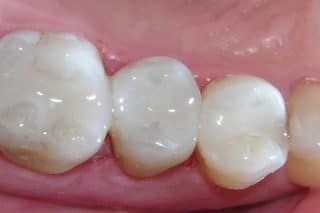White Fillings

White fillings placed directly in your mouth (composites).
Indirect white fillings (porcelain inlays/onlays).
Indirect white fillings (made of composite).
Crowns.
WHITE FILLINGS PLACED DIRECTLY IN YOUR MOUTH (COMPOSITES).
Composite resins are tooth coloured fillings that are made of a plastic material mixed with filler and are suitable for small to medium sized fillings. Due to budget reasons, sometimes this material is used on larger back teeth at the patient’s request, understanding the limitations and weaknesses of the material. The material is inserted into a cavity in the paste form and set hard with a special light.
Advantages of Composite Fillings.
Composite fillings are more attractive than amalgam fillings.
Teeth may be strengthened as it bonds to the surrounding tooth, while an amalgam may sometimes weaken a tooth.
Composite fillings can be fitted into very small holes, avoiding more drilling for the preparation of the tooth.
Disadvantages of Composite Fillings.
In larger fillings, composite fillings can wear out sooner than amalgam and porcelain fillings. If the cavity is very small, this is not the case.
This is because plastics shrink when they polymerize, causing white lines between the filling and tooth, which can eventually fill with stains. Shrinkage at the base of the filling can cause sensitivity when biting on crunchy foods.
Some food and drinks can stain composite fillings.
Composite fillings are not as strong as porcelain or amalgam and may fracture more readily.
If the filling does not touch the adjacent tooth tightly, Food can get jammed between the teeth.Composite fillings can not be packed into a cavity with the same pressure as an amalgam. At times, a fine gap may open when chewing fibrous foods such as meat.
INDIRECT WHITE FILLINGS (PORCELAIN INLAYS/ONLAYS).
Onlays and inlays are used to repair moderately damaged back teeth and need to be strong to withstand the grinding pressure of these teeth. When a filling is deep or very wide it becomes almost impossible to make a good quality filling without taking moulds of your tooth and making the filling outside of your mouth.
The first visit involves removing the old filling or decayed tooth structure and preparing the surface for the new filling. An impression is made of the area and sent to the dental laboratory so the filling can be constructed.
At the second visit, the filling is removed and the inlay/onlay is fitted and bonded into place then polished.
At our dental practice the two visits can be done together thanks assistance from the computer generated design and milling of the ceramic also known as” CAD-CAM dentistry”. This will save you time and also give optimum outcomes for bonding the ceramic onlay/inlay to the tooth.
Advantages of Inlays/Onlays.
Strength is the major advantage. Fillings usually weaken teeth. Inlays/onlays are bonded directly into the tooth and can increase the overall strength of the tooth.
They are durable.
They can be a good alternative to a crown.
High accuracy also means there is less likelihood of loose contact between adjacent teeth and hence can avoid food getting stuck between the teeth. Such food traps can lead to decay and gum disease.
Unlike composite fillings, they do not shrink while being placed and have a less incidence of sensitivity.
Disadvantages of Inlays/Onlays.
They are more expensive than direct fillings due to the high-quality materials required to manufacture them and the precision required in their fitting.
Because the porcelain is brittle, occasionally they can fracture. Some people’s bites are heavier and stronger leading to fracture. Accidents, such as biting into a stone whilst eating, can cause a sudden hard impact in the porcelain and may initiate a crack.
INDIRECT WHITE FILLINGS (MADE OF COMPOSITE).
Indirect composite fillings are made similarly to a porcelain inlay/onlay however the material used is composite resin instead of porcelain.
Advantages of Indirect White Fillings.
They are more accurate than direct composite fillings.
Because they are done outside of the mouth, the fillings have better physical properties and anatomy.
They are cheaper than porcelain fillings.
Disadvantages of Indirect White Fillings.
They are still made of a plastic material and therefore can wear out sooner and can fracture.
WHAT ABOUT AMALGAM FILLINGS?
Amalgam is a metal alloy of silver, mercury, tin and copper. It is made by mixing equal weights of mercury and a powder of copper, silver and tin. After mixing, the material sets hard over a few hours.
Advantages of Amalgams.
They may not take as long to place as a white filling.
They can be more durable and stronger than a composite filling.
Over time, products are released from the amalgam which seals the microspace between it and the cavity. This can reduce the likelihood of sensitivity and seal out bacteria.
Disadvantages of Amalgams.
They are not environmentally friendly.
Mercury is an integral part of an amalgam, however it is not in the liquid form but rather it forms compounds with silver and tin.
Medium to large sized amalgams can lead and weaken a tooth to cracks and fractures to the tooth.
WHICH FILLING TYPE SHOULD I HAVE?
We will recommend the best material to meet your specific needs. Longevity of any of the restorations depend on the quality of the materials and the technical skills in construction and placement (we continually review our techniques to ensure we have the best possible technical skills), and how you maintain the fillings or crowns once they are in your mouth.
Clenching and grinding habits will significantly shorten the useful life of any restoration placed. Food and clenching can break your natural tooth and likewise break any restoration. When it is small and simpler to fix, we recommend six monthly check ups and cleaning appointments as problems can be identified and corrected.
WHAT IS THE DIFFERENCE BETWEEN A CROWN MADE BY A DENTAL CLINIC SPECIALIST AND ELSEWHERE?
We also ensure that all materials used by our technicians are of the highest quality and approved. We have made a decision in our practice to provide you with the best and most appropriate procedures and materials that dentistry has to offer and we consider your overall medical health.
Want to know more or book an appointment? Please contact us.

